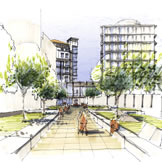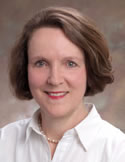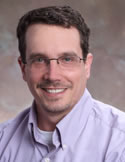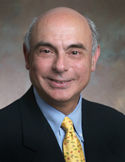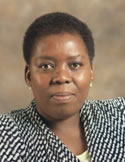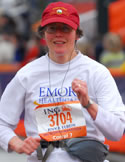
April 14, 2008 |
Leadership Retreat Explores WHSC Potential | |||||||||
|
Internationally recognized author and lecturer Dr. Frank LaFasto defines teamwork as "people with different views and perspectives coming together, putting aside their narrow self-interests, and discussing issues openly and supportively in an attempt to achieve a broader goal." That’s just what happened on March 19 when 75 Woodruff Health Sciences Center (WHSC) leaders got together for Team Excellence, the WHSC leadership retreat. The key retreat goals were twofold: to establish a common understanding of team excellence and to understand the theory of sustained competitive advantage and apply it to WHSC activities. Dr. LaFasto himself led a stimulating, interactive discussion of what it means to be an outstanding team member and how excellence in teams is achieved. I had the challenging task of following the excellent session with Dr. LaFasto to lead the discussion on sustained competitive advantage. Attendees then participated in a breakout session in which several small teams each identified a program or area in which WHSC is uniquely qualified to succeed and the competitive advantages that distinguish it. The entire group showed an impressive level of engagement and enthusiasm for exploring the extraordinary potential of some of our most promising programs. Their work really helped set the stage to better understand what makes WHSC unique among academic health centers and to identify how we can become the paradigm that other centers emulate.’ Another important outcome of the retreat was consensus among our senior leaders that we need to better clarify the WHSC goals developed over the past few years. Several retreat participants volunteered to help look at how we can communicate our goals more clearly, and the WHSC Agenda Committee is taking this on as a key agenda item. We’re also getting feedback from a broad group of leaders across WHSC and the university. Team Excellence was an outstanding opportunity to continue dialogue around issues that are crucial to accelerating our momentum. We will continue to get together regularly to engage in conversation about our unique assets and how best to leverage them. And of course, I’ll continue to share with you the important outcomes of these meetings as they take place and as they help us transform health and healing. |
|||||||||
|
Groundbreaking set for new public health building On May 30 at 11:00 a.m., Emory officials will lift shovels to break ground for the Claudia Nance Rollins Building for the Rollins School of Public Health. Projected to open in 2010, the building will be located behind the Grace Crum Rollins Building and linked to that building via a pedestrian bridge. The school has tripled its number of students, faculty, and research dollars since its first building opened in 1995, and the new building will consolidate classrooms, labs, and offices, adding more than 190,000 square feet of space to the school. The Claudia Nance Rollins Building will house a 250-seat state-of-the-art auditorium and new conference capabilities to enhance specialized training, distance learning, and professional exchange programs. "The building will allow us to host events for the public and serve as a destination point for public health professionals in Atlanta. It will also house the university’s Global Health Institute and will strengthen the school’s collaborations both within and outside Emory, serving as a landmark space for partnership and community," says Dean James W. Curran. The building is made possible by a $50 million commitment from the O. Wayne Rollins Foundation and from Grace Crum Rollins (widow of O. Wayne Rollins) and will be named for John and Wayne Rollins’ mother. Wayne Rollins was a self-made business entrepreneur who orchestrated what is often recognized as the first leveraged buyout. He and his brother John participated in numerous successful business ventures, including radio and TV stations, pest control, oil field services, truck leasing, boat manufacturing, and real estate. Wayne’s sons, Gary and Randall, have continued to build the Rollins companies since their father’s death in 1991. This most recent gift is one of many from the Rollins family to Emory and to public health in particular. To read more about the building, see article in Public Health magazine. |
|||||||||
|
Satellite investigational pharmacy opens in clinic A new Emory Investigational Drug Service (IDS) satellite location in Emory Clinic A offers increased accessibility to clinical investigators on the Emory campus. The new location adds to the services offered by the IDS pharmacy located on the fifth floor of Emory University Hospital. The IDS also has agreements with the pharmacies at the VA Medical Center, Grady Hospital, and Children’s Healthcare of Atlanta to provide investigational drug services. A new policy adopted January 1 by the university and medical school decreed that any new clinical study involving the use of investigational drugs be managed through the IDS. The policy applies to all investigational drugs or drugs provided free of charge in clinical studies. As director of Emory’s IDS, Susan Rogers has seen a lot of changes over the years in how drugs for clinical trials are dispensed and tracked. An old-fashioned paper system has given way to a web IDS that records every step involved in ordering, dispensing, and tracking each drug involved in clinical studies at Emory. "Each study is different, and every drug company has its own requirements for how drugs are handled and logged," says Rogers, who expects the number of protocols processed to increase from about 165 at the beginning of the year to 250 to 300 with the new policy. New services and technologies are improving the process of dispensing and tracking investigational drugs. One new pharmacist, a technician, and a part-time student have been added to the IDS staff. And the IDS now offers a courier service on the Emory campus to speed delivery of investigational drugs. A new computerized temperature tracking system continuously monitors temperatures in all drug storage areas. The system automatically delivers a daily summary of temperatures, meeting the strict temperature maintenance requirements of many studies. If the temperature falls out of the acceptable range, the system alerts a pharmacist to fix the problem. "Although many of our investigators already used the IDS, this new satellite pharmacy will make it easier for everyone to comply with the new mandatory policy," says David Wynes, Emory vice president for research administration. "We expect to be able to handle the many complex requirements of investigational drug trials more efficiently and safely." Wynes says the uniform policy for investigational drug management also will help Emory satisfy FDA drug accountability regulations, meet JCAHO hospital accreditation standards, satisfy accreditation standards for the institutional review board, and minimize liability for Emory and its clinical investigators through improved drug security, safety, and accountability. |
|||||||||
|
This is part of an ongoing series of profiles of those who help support major areas throughout the Woodruff Health Sciences Center. You think you have workplace challenges? What if those you were responsible for were smart but mischievous, enjoyed pulling apart their work space, expected you to keep them fed, clean, well, and entertained, and sometimes woke you in the middle of the night with vociferous cries of pleasure or annoyance? If you were Mark Sharpless, you would love every minute of it. Being operations manager at the 117-acre Yerkes field station in Lawrenceville is a 24-7 job, but Sharpless doesn’t have to take his work home: He lives in a house on the grounds, along with his two dogs and a pot-bellied pig named Ellie. Charged with overseeing the field station’s daily operations, Sharpless is the go-to person for anything having to do with 2,200 animals living in open-air compounds in large social groups of 20 to 175. Sharpless facilitates research, the center’s breeding program, and good relations with the Lawrenceville human community, but his first priority is what’s good for the animals. He oversees and manages training for 25 staffers who handle daily husbandry, making sure the animals are fed, clean, safe, and secure. He coordinates efforts of on-site facilities staff and on-site contractors. Members of the veterinary care team report to the chief vet for medical guidance but turn to Sharpless to get things done. Four Yerkes researchers spend most of their time at the field station, known worldwide for its studies of social behaviors among primates, and many others are at the field station for short-term studies. There’s a lot of balancing of research and animal care schedules, says Sharpless. Each animal is looked at every day by some combination of himself, associate operations manager Julie Moran (who lives close by), the animal care staff, veterinary staff, and the researchers. Already, 2008 has been a busy year for Sharpless, with a successful renewal site visit from the Association for Assessment and Accreditation of Laboratory Animal Care International (the gold standard of animal care accreditation). As the breeding center for Yerkes, the station moved forward with the time-consuming, labor-intensive breeding of a colony of herpes b negative macaques, animals important in vaccine and transplant studies, and the recent groundbreaking for a clinical veterinary medicine administration and research building, scheduled to open later this year. Planning also is under way for a new garden to grow fruit and produce for the animals. Visitors include neighbors, often bearing gifts of treats made by nursing home residents or old phone books for the animals to destroy, school children, visiting scientists, and actor Alan Alda who filmed part of a new television program on research at the field station in March. Spring is the best time of year at the field station, says Sharpless, because it’s birthing season, but every day is filled with excitement, the joy of living among the animals, and working with dedicated staff who love them as much as he does. |
|||||||||
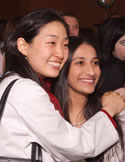 |
• Excellent match day this year The success of this year’s Match Day suggests that the financial crisis at Grady Hospital had no negative impact on Emory’s ability to attract residents, about one-third of whom train at Grady at any given time, according to the medical school’s associate dean for graduate medical education, James Zaidan. The quality and breadth of the training experience at Grady traditionally has served as a plus in attracting highly competitive applicants. This seemed to be a year, in fact, in which many of those on both sides of the process--students looking for residencies and schools looking to fill slots--got what they were looking for. According to the National Resident Matching Program (NRMP), which matches students with residency programs throughout the country, more than 94% of seniors applying for residencies were paired with a program of their choice, the highest percentage in more than three decades. For more information on the national match, see press release from the Association of American Medical Colleges. Of the 108 Emory senior medical students participating in the NRMP, 36 will spend all or part of their training in Emory’s residency programs, a proportion that has remained consistent over many years, says Zaidan. For details on how Emory’s medical students did in this year’s match and the specialties they chose, see Emory press release. |
|||||||||
|
||||||||||
 |
• Internal web site covers Campaign Emory Campaign Emory, a comprehensive fund-raising effort to support Emory’s strategic plan, will launch publicly on September 25, but faculty, staff, and students can learn about it now at a web site called Campaign Insider that is accessible via network ID and password. In addition to introducing the campaign, the site answers frequently asked questions and includes key campaign personnel and volunteer leaders. Read more about the campaign’s objectives in an article from Emory Report. |
|||||||||
|
• Johns appointed to Georgia’s Save the Cure Commission Governor Sonny Perdue recently appointed Emory chancellor and former health sciences center CEO Michael Johns to the Georgia Commission for Saving the Cure. He will be one of 15 members on this commission, which was created in the 2007 state legislative session to establish the Newborn Umbilical Cord Blood Bank, a network of banks to make postnatal tissue and fluid available for research and treatment. The commission is also charged with developing a program to inform pregnant women of the availability of the blood and tissue bank and its purpose for existence. For a complete list of recent honors and appointments, please see web site.) |
|||||||||
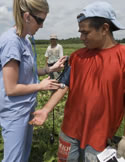 |
• Book showcases nurses around the world Nurse: A World of Care features 220 pages of photos and narrative depicting nurses and the challenges they face in caring for the world’s most vulnerable people. The brainchild of nursing dean Marla Salmon, who is senior editor, the book illustrates the importance of nursing in the fabric of society and underscores the shortage of nurses worldwide. Several Emory staff nurses and nursing students, including the one at left, are featured in the book, which was published by Emory University, with funding also provided by Johnson & Johnson. The book is available for $29.95 at this site or wherever books are sold, with proceeds benefiting the nursing school’s Lillian Carter Center for International Nursing. |
|||||||||
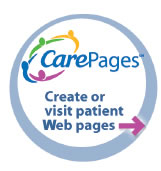 |
• Emory Healthcare site helps patients connect Patients and their loved ones can communicate easily with one another during a lengthy medical experience via CarePages, a new service on Emory Healthcare’s web site. CarePages are private, personalized web pages providing users with control over communication while also allowing friends and family to respond with messages of support. The service can include patient updates, photo galleries, and message boards. For more information, see press release. |
|||||||||
|
• Outspoken South African legislator will speak on leadership in democracy Nozizwe Madlala-Routledge, a former deputy health minister in South Africa and a current member of parliament, will present "Democracy Needs Leaders Who are Prepared to Serve the People," on Wednesday, April 23, at 4 p.m. in the School of Medicine Building, room 120. She is the Emory Global Health Institute’s first distinguished visiting fellow. During her tenure as former deputy minister of health under President Thabo Mbeki, Madlala-Routledge advocated use of science-based treatments such as antiretroviral therapy to stem South Africa’s HIV/AIDS epidemic. She was dismissed last year from her post in the health ministry amid controversy following an unauthorized trip to an AIDS vaccine conference in Spain as well as comments about the dismal conditions at East London’s Frere Maternity Hospital, a site of high infant mortality. Her work to turn back South Africa’s rise in HIV/AIDS cases challenged other officials’ assertions that the disease did not exist, and that specific foods, such as garlic, could be considered suitable treatments. |
|||||||||
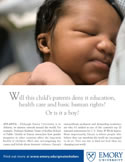 |
• Watch for Emory ads on your next Delta flight Among the ads that Emory’s marketing officers recently placed in issues of Delta’s Sky magazine are two focusing on the work of researchers in health sciences: Frans de Waal at Yerkes (conflict resolution, March issue) and Kathryn Yount in public health (effect of gender inequities in other countries on long-term health of children, May issue). You can view the ads online for de Waal and Yount. The ads are part of a spring ad campaign to build Emory’s national brand awareness. |
|||||||||
 |
• Emory Healthcare sponsors health sessions at Whole Foods Once a month (third Wednesday) at 6:30 p.m. from now through October, Emory Healthcare is partnering with Whole Foods Market to present free lectures along with product/cooking demonstrations and samples at the Whole Foods Midtown at 650 Ponce de Leon Avenue. Upcoming topics include allergies, relaxation/stress, bone and joint health (and how to run the Peachtree Road Race injury free), skin care/aging gracefully, nutritional supplements, babies and kids/baby food, and breast cancer. To register, complete the online form at the Emory Healthcare Events site. |
|||||||||
|
• Going the extra mile The 15,000 runners, walkers, and wheelchair participants in last month’s ING Georgia Marathon were well served by Emory volunteers, who deserve a big thank-you for their work on this event. Emory Healthcare was an official race sponsor and the leading medical provider, with 25 clinicians stationed at four tents along the 26.2-mile course. Another 100 Emory volunteers--ranging from laundry supervisors and OR staff to medical students--supported the marathoners at hydration stations. The station at mile 21, for example, had 1,600 gallons of water, 400 gallons of Gatorade, 50,000 cups, and 20 tables to form 160 feet of hydration support. Emory was also well represented among race participants, including clinical research nurse Rivka Elbein at left (photo by Kristopher Cargile). Special thanks to leadership provided by chief volunteer coordinator Paige Dunham, to hydration team captains John Duckworth and Tammy Lowe, and to emergency medicine physician Ian Greenwald. |
|||||||||
 |
• Listen to women in health sciences Four Emory women in health sciences are among 30 whose memories and life stories are captured in podcast interviews produced in an oral history project underwritten by the President’s Commission on the Status of Women. The four included thus far in this ongoing project are Donna Brogan (professor emerita and first female chair of biostatistics, school of public health), Edith Honeycutt (nursing school alumna and private nurse to four generations of Atlanta’s Woodruff family), Nanette Wenger (chief of cardiology, Grady Hospital), and Sylvia Wrobel (former associate VP, Health Sciences Communications). For more information, see article in Emory Report. |
|||||||||
 |
• Share the news Next time you’re reading a health sciences press release online, remember there’s an easy and free way to share it, using social news/bookmarking services such as Digg, de.icio.us, Reddit, and Stumble Upon. Buttons for these services, like the ones at left, have been added to each release. Such services allow users to share news items they find interesting as well as keep track of web sites by creating online bookmarks. For an instructive and fun overview of social news/bookmarking, watch a short video: "Social Bookmarking in Plain English." |


